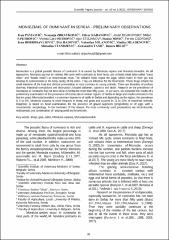Monieziais of ruminant in Serbia - preliminary observations

View/
Date
2022Author
Pavlović, Ivan
Zdravković, Nemanja
Radanović, Oliver
Bojkovski, Jovan
Petrović, Milan
Caro-Petrović, Violeta
Stojanov, Igor
Minić, Stanko
Csordás, Ferenc
Dobrosavljević, Ivan
Radović, Bisa
Milanović, Valentina
Mladenović, Vladica
Stanojević, Slobodan
Tasić, Aleksandra
Relić, Renata
Metadata
Show full item recordAbstract
Monieziais is a global parasite disease of ruminants. It is caused by Moniezia expans and Moniezia benedini. As all
tapeworms, Moniezia spp has an indirect life cycle with ruminants as final hosts, and oribatid mites (also called "moss
mites" and "beetle mites") as intermediate hosts. The oribatid mites ingest the eggs, which hatch in their gut and
develop to cysticercoids in the body cavity of the mites. They are infective for the final hosts. These thugs inhabit the
small intestine of the host and clinical presentation is most common in young animals. There are disorders of profuse
diarrhea, intestinal convulsions and obstruction, bloated abdomen, cachexia and death. Research on the prevalence of
monieziais in ruminants has not been done in Serbia for more than fifty years. In our work, we presented the results of a
preliminary examination of the prevalence of monieziais in certain regions of Serbia in large and small ruminants in the
last ten years. Moniezia benedeni is a common tapeworm of cattle in Serbia and depending on the region, the prevalence
is 3 to 5%. Moniezia expansa is more frequent in sheep and goats and occured in 11 to 23% of examined animals.
Diagnosis is based on fecal examination for the presence of gravid segments (proglottids) or of eggs with a
characteristic morphology. In the treatment of the disease, the most commonly used preparations are bezamidazole,
niclosamide, and combination of praziquantel and levamisole.
